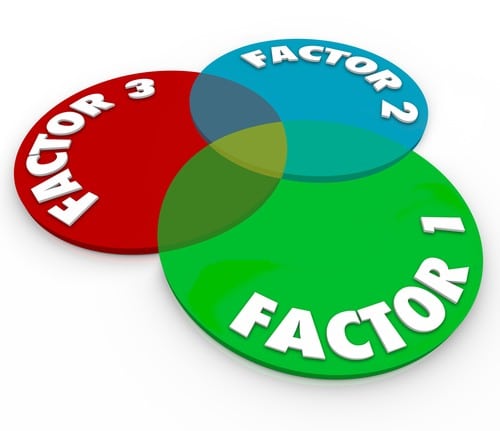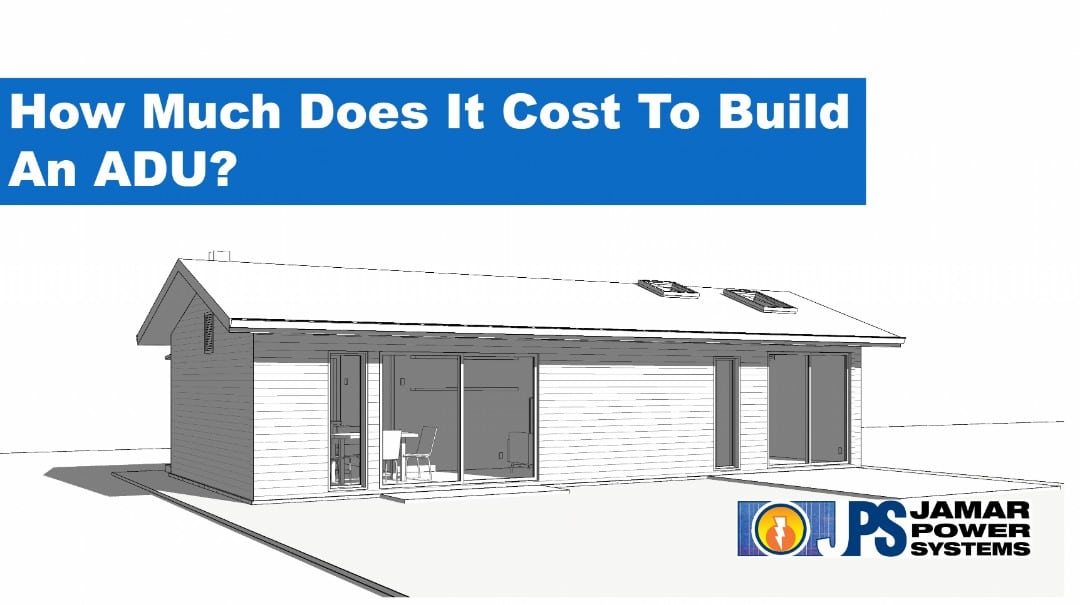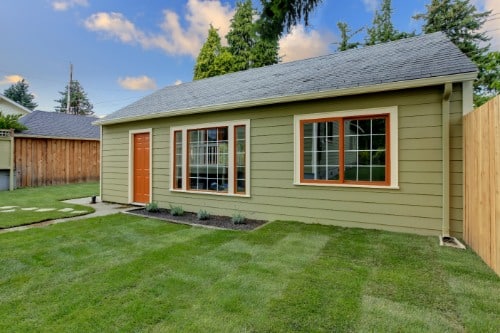How Much Does It Cost To Build An Accessory Dwelling Unit?
Need help with the myriad of prices, options, and details involved when considering building an Accessory Dwelling Unit (ADU)? You’re not alone; it’s a big step with various factors to consider.
This article will dive deep into what an ADU is, the breakdown of how much it costs to build an ADU, including everything from materials to permits, and weigh potential advantages and disadvantages. Stick around if you want clarity on spending wisely while creating your dream space!

Factors That Influence Accessory Dwelling Unit (ADU) Cost
The cost breakdown of building an ADU includes factors such as size, type, design costs, materials, foundation, framing, finishing, systems, labor, and permits.
Size
Understanding the costs of building an Accessory Dwelling Unit (ADU) starts with analyzing the size. The scope of your project will significantly influence the construction expenses, as larger ADUs naturally require more resources and labor than smaller ones.
If you choose a sizable 1200 sq ft layout over a modest 400 sq ft design, your final bill may differ by thousands of dollars.
The size of your ADU determines not only the material and labor costs but also the overall utility cost down the line. Bigger ADUs will require more heating, cooling, and lighting energy, resulting in higher utility bills.
Type
Understandably, the Accessory Dwelling Unit (ADU) type significantly influences its cost. This category covers varieties like basement conversions, garage conversions, attached ADUs, and more complex detached or above-garage units.
The cost of a simple basement conversion would depend on the size and the extent of renovations needed. Alternatively, an above-garage or detached unit could be more expensive because these often require laying new foundations and more extensive materials and labor costs.
Consider that initial construction costs for types like those mentioned above can be higher than others, such as prefab ADUs.
The type of ADU also affects your property’s value. Detached units often add more value as they offer greater privacy and flexibility. On the other hand, garage conversions might not appeal to future buyers who prefer having a garage space for their vehicles or storage.
Design Costs
Design costs are a significant fraction of the overall expenses of building an accessory dwelling unit (ADU). They cover aspects like architectural designs, floor plans, and any unique features you may want in your ADU.
The cost varies widely based on the complexity of the design and professional fees for architects or engineers.
It’s worth noting that these estimates can significantly increase for custom designs from seasoned professionals.
Although professional design services can be costly, they may save money in the long run. A well-designed ADU will likely be more efficient and functional, potentially reducing future renovation or maintenance costs. Good design can also enhance your property’s value, leading to better returns if you sell.
Materials
The materials you choose for your accessory dwelling unit (ADU) can significantly impact the overall cost of construction. Each material selection has its price tag, from the foundation to the finishing touches. Materials costs should also include appliances for the unit.
It’s essential to consider both quality and budget when making these decisions. Remember that ADUs typically have a smaller footprint than traditional homes, so you’ll need fewer materials overall.
Choosing sustainable or energy-efficient materials can lead to cost savings in the long term. For example, energy-efficient windows or insulation can reduce heating and cooling costs.
Foundation
The foundation is critical when building an accessory dwelling unit (ADU). It plays a significant role in the overall cost. The type of foundation you choose can significantly impact the construction expenses for your ADU.
Generally, the two main types of foundations commonly used for ADUs are slab-on-grade and raised foundations. Slab-on-grade foundations are more cost-effective as they involve pouring concrete directly onto the ground and do not require extensive excavation or additional materials.
Choosing a type of foundation is not just a cost decision but also affects the durability and stability of the ADU. While slab-on-grade foundations are cost-effective, they may perform poorly in areas with poor soil conditions or prone to earthquakes.
Framing
Framing is crucial in constructing an accessory dwelling unit (ADU), as it provides the structural framework for the entire building. Regarding ADU construction costs, framing can significantly impact the overall budget.
The good news is that ADUs are often built with cost-effective one- or two-story wood frames, which are less expensive than other construction types. It helps to keep costs down while ensuring a sturdy and durable structure.
Using affordable framing techniques, homeowners can save money without compromising quality. Prefabricated ADUs also offer a cost-effective option, as they come with pre-built frames to assemble on-site, reducing labor and materials costs quickly.
Framing choices could impact the insulation properties of your ADU. Using advanced framing techniques or better-quality framing materials can increase your ADU’s energy efficiency, reducing energy costs in the long run.
Finishing
Finishing is critical to building an accessory dwelling unit (ADU) and can significantly impact the overall cost. This phase includes all the final touches, such as flooring, cabinetry, fixtures, paint, and landscaping.
While it may seem like a small part of the construction process, finishing expenses can add up quickly. Keep in mind that high-end finishes or custom features may increase this estimate.
The choice of finishing can greatly impact the ADU’s appeal and durability. High-quality finishes are not just aesthetically pleasing but are also likely to be more durable, resisting wear and tear better.
Systems
When building an accessory dwelling unit (ADU), one crucial aspect to consider is the cost breakdown of the systems involved. These systems include electrical, plumbing, HVAC, and other essential components necessary for a functional living space.
The price of these systems can vary depending on factors such as size, complexity, and the specific needs of your ADU. On average, homeowners can allocate a significant portion of their budget toward these systems.
It’s important to factor in these costs during the planning and design stages to ensure your ADU meets all safety standards and provides the comfort you desire.
Investing in energy-efficient systems such as a high-efficiency HVAC or LED lighting can lead to substantial energy savings over time.
Labor
The labor costs for building an accessory dwelling unit (ADU) are a significant factor in the cost breakdown. The amount of labor required will depend on the size and complexity of the project.
It’s important to note that labor costs vary depending on location and contractor rates. Additionally, suppose you hire specialized tradespeople or contractors for plumbing or electrical work. In that case, these expenses will contribute to the overall labor costs.
Therefore, when planning your ADU budget, it’s crucial to consider materials and labor factors together to get a more accurate estimate of your total investment.
Hiring experienced and skilled workers may increase initial labor costs but could save money in the long run.
Permits
The necessary permits are essential when building an Accessory Dwelling Unit (ADU). These permits ensure that your project meets all local regulations and codes, ensuring safety and compliance.
However, it’s essential to consider the cost of permits in your overall ADU budget. Permit costs can vary depending on your location and the specific requirements set by your local government.
Investigating additional expenses is crucial when estimating the total cost breakdown of constructing an ADU. While permit costs may seem burdensome, they protect you from legal issues arising from non-compliance with local codes.
ADU Costs By Type
Learn about the specific costs associated with different types of ADUs, from basement conversions to detached units.
Basement Conversion ADU
Basement conversion ADUs are a popular and cost-effective option for homeowners looking to add living space to their property. By converting an existing basement into a separate unit, you can maximize your property’s potential without needing new construction.
Additionally, homeowners should consider expenses such as permits and utility connection costs when budgeting for their basement ADU project. Despite these considerations, a basement conversion ADU can be an excellent way to create additional living space while maximizing your investment.
Garage Conversion ADU
Converting a garage into an accessory dwelling unit (ADU) is often the most cost-effective option for homeowners looking to add extra living space to their property.
It is an excellent choice for those on a modest budget who want to maximize the use of existing space. By repurposing an underused garage, homeowners can create a flexible living area for a rental unit.
Plus, since the structure already exists, there are typically fewer design and construction costs than other types of ADUs. If you want to expand your home without breaking the bank, consider converting your garage into an ADU.
Attached ADU
Attached ADUs are an increasingly popular option for homeowners looking to expand their living space. These units are connected to the main house and often share a wall or common area. When it comes to cost, building an attached ADU can be more affordable compared to other types.
It’s essential to consider these cost considerations before starting your project so that you can plan your budget accordingly and make informed decisions about the size and layout of your attached ADU.
Detached ADU
A detached Accessory Dwelling Unit (ADU), a granny flat, is a separate living space built on the same property as the main house. The cost of constructing a detached ADU can vary depending on size, design, materials, and location.
It’s important to note that hidden costs, such as permits and utility connections, are involved in the construction process.
Despite the expenses, building a detached ADU can be a cost-effective solution for creating additional living space or generating rental income. There are also budget-friendly options available by exploring affordable construction methods and materials.
What’s One Drawback of an ADU?
One potential drawback of building an ADU is the cost. ADUs require money to construct and maintain, which can significantly increase monthly utility bills for homeowners. Additionally, obtaining government approval and permits for building ADUs can be challenging.
However, despite these drawbacks, ADUs can still be a good option for homeowners on a tight budget who want to expand their living space and gain more independence. They provide additional accommodation options within existing single-family dwellings and can add value to a property.
Considering the financial implications and ongoing maintenance costs before building an ADU is essential.
Is An ADU A Good Investment?
ADUs, also known as granny flats or in-law suites, have become a popular investment option for homeowners looking to increase their property’s value and generate additional income. Building an ADU can be a wise financial decision that offers numerous benefits.
With the rising demand for affordable housing and rental options, an ADU provides the opportunity to tap into the growing market.
Not only can an ADU provide you with a steady stream of rental income, but it also increases your property’s value. Adding this additional dwelling unit boosts your home’s appeal to potential buyers and enhances its marketability.
As real estate developers continue to recognize the profit potential of ADUs, they are becoming more mainstream in many areas.
Furthermore, constructing an ADU allows you to expand your living space without significant renovations or to purchase a new property. This cost-effective alternative is beautiful for homeowners seeking to accommodate multigenerational living arrangements or create separate spaces for guests or home offices.
Considered a long-term investment in an unpredictable world, building an ADU not only improves your quality of life but also offers financial security. Investing in an ADU has proven worthwhile whether you choose a basement conversion, garage conversion, attached or detached unit, or even opt for prefabricated construction methods on a budget.
Why Does The Cost To Build An ADU Vary?
The cost to build an Accessory Dwelling Unit (ADU) can vary significantly based on several factors. Firstly, geographical location plays a considerable role. The labor, materials, and permit costs can vary substantially from one region to another, largely driven by local economic conditions.
For instance, building an ADU in a metropolitan area with a high cost of living, like San Francisco, would be significantly more expensive than in a smaller city with a lower cost of living.
The chosen design, size, and type of the ADU will also directly influence the cost. A larger, custom-designed detached ADU would require more materials and labor and thus be more expensive than a smaller, prefabricated, or converted ADU.
Similarly, higher-end finishes, fixtures, and premium appliances would drive up the cost compared to more modest selections.
The existing infrastructure of the property is another significant variable. For example, if the property’s electrical or plumbing systems need upgrading to accommodate the ADU or significant excavation is required, these would add to the overall cost.
Finally, fluctuating market prices for materials and labor can also lead to variations in cost. During high demand or supply shortages, construction materials and labor prices can surge, leading to higher costs.
Therefore, timing your ADU project to take advantage of more favorable market conditions could lead to savings.
Does Adding An ADU Increase Property Value?
Adding an Accessory Dwelling Unit (ADU) to your property may increase its value significantly. Studies have shown that homes with an ADU are priced 35% higher, on average, in major cities compared to those without one.
An ADU is a good investment. It can improve the value of your home by up to 30%. The specific increase in property value will depend on factors such as the size of the ADU and its location as well as the overall economy and real estate market.
So, if you’re considering building an ADU on your property, rest assured that it has the potential to provide both financial benefits and enhanced market appeal.
Conclusion
Building an Accessory Dwelling Unit (ADU) can seem daunting, considering the various factors affecting its cost. However, while there may be hidden expenses and additional costs, the potential benefits of ADUs are undeniable. They offer homeowners a more affordable and versatile housing option than traditional single-family homes, adding value to their existing property.
With accessible online tools, such as calculators, to estimate construction costs and a broad spectrum of ADU types, homeowners have greater flexibility and control in creating their dream accessory dwelling unit.
Furthermore, ADUs offer potential for rental income, making them a valuable investment.
We understand that each project has unique needs and challenges.
Related Articles:
New Home Construction Electrical Costs
Solar Energy Systems for Home Builders
Electrical Services for New Home Builders
Electrical Requirements for ADUs in California
How Much Does It Cost To Build An ADU?
To speak with our experts, contact our office at (619) 448-7770 or fill out our web form here and we'll get in contact asap.
- How Solar Batteries Work - March 4, 2024
- Solar Battery or Generator for Emergency Backup Power? - January 30, 2024
- How to Check If Your Solar Panels Are Charging The Solar Battery - January 12, 2024






